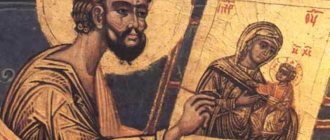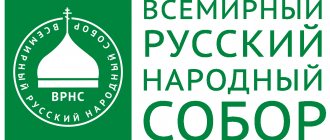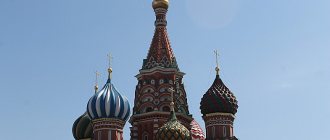The 11th canon of the Sixth Ecumenical Council and modern Judaism
This article is the end of my recent publication on RNL “Pan-Orthodox Council and the possibility of changing Orthodox canons.” However, since the Pan-Orthodox Council did not actually take place, I decided to call this article differently, closer to its essence. So, let me remind the reader what we are talking about. The fact is that this very 11th canon of the Sixth Ecumenical Council reads: “None of those belonging to the sacred rank, or of the laity, should at all eat unleavened bread given by the Jews, nor enter into fellowship with them, nor call upon them when sick, and take medicine from them, neither in the baths nor wash with them. If anyone dares to do this, then the cleric will be deposed, and the layman will be excommunicated.”
In this regard, some fairly well-known figures of the Russian Orthodox Church express the opinion that this rule, especially in some of its parts, is supposedly outdated. In this case, opponents of strict observance of the canons especially pay attention to that part of this rule, in their opinion, “completely impossible”, where it was forbidden to wash in the same bathhouse with the Jews. “How can you find out whether at least one Jew washes in a bathhouse or not, and who can forbid him to wash in a common bathhouse,” they exclaimed pathetically with a strained voice, trying to use this example to prove the impracticability of the ancient canonical rules in our time.
Meanwhile, in the first part of this article (“Pan-Orthodox Council and the possibility of changing Orthodox canons”), it was shown that for the correct understanding and application of Orthodox canonical rules, one must look not only at the letter of the law, but also at its spirit, “because the letter kills , and the spirit gives life” (2 Cor. 3: 8), - which is fully applicable to the 11th rule. After all, it is absolutely obvious that if you look not at its letter, but at the spirit of this canonical rule, then it is by no means only “about a Jew in a bathhouse,” as some would like to see! No, here Orthodox Christians are warned against dangerous communication with Jews, i.e. with persons of Jewish nationality who devoutly profess Judaism. Moreover, in the previous part of this article examples of the sad consequences of such communication were given.
However, at the end of that publication, I noticed that everything said in it about Judaism, of course, is correct, but this is only a movement in the right direction. Almost one and a half thousand years have passed since the Sixth Ecumenical Council. Since then, the situation in this regard has deteriorated greatly. Therefore, a significant addition to what has been said is required. What is it about?
As the Gospel prophesies and church history testifies, Satan, in his struggle with the Church of Christ, first mistakenly relied on paganism. Let us recall at least three centuries of pagan persecution of Christians. However, later, realizing his mistake, he reoriented himself to Judaism.
There is the following gospel parable on this subject: “In one city there was a judge who was not afraid of God and was not ashamed of people. In the same city there was a widow, and she came to him and said: protect me from my rival. But for a long time he didn’t want to. And then he said to himself: although I do not fear God and am not ashamed of people, yet, just as this widow does not give me peace, I will protect her so that she will no longer come to bother me” (Luke 18: 2-5).
The Holy Fathers interpret this parable this way: an unrighteous judge who did not fear God and was not ashamed of people is the devil. The poor widow is the Jewish people: the widow because she did not accept the Bridegroom Christ, and the poor because for this she was rejected by God and lost everything, even her own land, from which she was expelled after the unfortunate uprisings against the Romans and the subsequent defeat of Jerusalem , a monument to which remains the famous Wailing Wall. The rival of this widow, i.e. Jews or their content of Judaism is Christianity.
So, the widow - the Jews or Judaism - constantly bothered the unjust judge, i.e. constantly filled themselves with the role of the main persecutors of Christianity. Indeed, the first persecution of Christians was carried out by the Jews after the murder of the first martyr Archdeacon Stephen. As the Acts of the Apostles say: “In those days there was a great persecution against the church in Jerusalem” (Acts 8:1). And in general, the Jews, which is positively commanded to them in the Talmud and is generally known, constantly and everywhere tried to harm Christians, if possible, by killing them or persecuting them. However, all these efforts of theirs, until a certain time, ended up on the periphery of church history. For Satan, seduced by the external power of paganism (the political power of the Roman Empire and the greatness of ancient culture), initially mistakenly relies on it in the fight against Christianity, and not on Judaism, which is “poor” in this regard.
Therefore, for example, the history of the first centuries of Christianity has preserved the tradition of persecution from the Jews as a relatively insignificant episode, but it very well remembers several hundred years of persecution from the pagans, and the number of martyrs who suffered from the latter at that time was much greater. In the same way, when the fight against Christianity took on a different form - the desire to pervert its doctrine through heresies stubbornly imposed on it, then at first, as the holy fathers who opposed these false teachings noticed, the latter had predominantly pagan roots.
When did the “unjust judge,” realizing his mistake, satisfy the “bothersome widow” - Judaism and make it his main weapon in the fight against Christianity? I think that in the 8th century after the Nativity of Christ, when the heresy of iconoclasm was conceived. Firstly, it is quite obvious that this heresy, unlike the previous ones, is of purely Jewish origin: the pagans, after all, revered and overly revered their sacred images, i.e. idols, namely in Judaism there was a ban on this, unjustifiably transferred to icons. Secondly, as is known from legend, the heresy of iconoclasm was inspired by the Jewish Magi, who inspired its first heresiarch, Emperor Leo the Isaurian, to begin a persecution of icons and icon-worshippers.
It is also interesting to note that, I think, this change of “horses in the crossing” by the devil did not go unnoticed by the Church. Two historical circumstances force us to think so. Firstly, the Seventh Ecumenical Council, which condemned iconoclasm and approved icon veneration, was the last ecumenical council in the history of the Orthodox Church. Secondly, the final victory over iconoclasm in the 9th century. according to R.H. The Church called it the Triumph of Orthodoxy. These events cannot be explained by the final victory over heresies, because even after iconoclasm there were new false teachings, for example, the heresy of Varlaam, who denied the uncreatedness of divine energies.
I think that with these two significant events the Church showed that heresies based on paganism have been finally defeated and will never again be the main enemy of Christianity. Judaism became his main enemy. And since it was exposed by the Lord as a false teaching during His earthly life and depicted in all its details in the Holy Scriptures, especially in the New Testament, then the need for a conciliar denunciation of it was in a sense abolished, for this there is Holy Scripture. That is why the Seventh Ecumenical Council, which condemned the first significant heresy based on Judaism, became the last ecumenical council in the history of the Church.
Now let's pay attention to the dates. The heresy of iconoclasm, which is a sign that Judaism became the main enemy of Christianity, began with the reign of Emperor Leo the Isaurian (717-741), i.e. from 717 A.D. And the Fifth-Sixth (Trullo) Council was in 691-692. according to R.H., i.e. literally on the eve of these events. It is obvious that St. The fathers of this council, through the action of the Holy Spirit, prophetically composed this 11th rule as one of the essential weapons in the fight against the new enemy of Christianity! For example, if Leo the Isaurian, guided by this rule, would not have listened to the Jewish wise men, who, along with a pea of truth, told him three boxes of lies, then he would not have become an evil iconoclast king, with all the ensuing consequences.
And on the other hand, reader, now you understand why there are now such attacks on precisely this 11th canon under the insignificant pretext of “the impossibility of not washing with Jews in bathhouses,” although in reality now the majority of Orthodox Christians wash not in them, but in their own bathrooms ?! Obviously, the point is not the ban, but the fact that this rule is directly directed against the main current enemy of Christianity - Judaism. It is the latter that inspires attacks on him. True, I don’t think that those liberal members of the Russian Orthodox Church who directly attack this rule are obvious Jews. Rather, they are simply Shabes goyim useful to Judaism, or, as they usually say, “useful idiots.”
In any case, from all of the above it is obvious that the 11th rule of the Sixth Ecumenical Council, contrary to the opinion of church liberals and modernists, is not only not outdated, but continues to remain one of the essential weapons in the fight against Judaism. So, for example, let’s look at its beginning, not in letter, but in spirit: “None of those belonging to the sacred order, or of the laity, should at all eat unleavened bread given by the Jews.”
I think that here, firstly, the direct acceptance of Jewish unleavened bread by a Christian is prohibited because of the psycho-physical desecration of it; and, secondly, there is also a categorical prohibition on complicity in ritual crimes, since in Christianity there is a fairly strong and stable idea that these unleavened breads cannot do without them.
How relevant this is is illustrated by, say, the current struggle of the Orthodox (in particular, at the RNL) with the film “Matilda”. Moreover, in a number of publications on RNL it was very reasonably shown that this film is another and very malicious attempt at ritual desecration of our people with the aim of once again involving them in complicity in the ritual murder of the Tsar-Martyr and His August Family. This is what causes the vast majority of our troubles!
Now, for further spiritual understanding of the 11th rule, it is necessary to at least briefly clarify what Judaism is? Usually, Judaism in the negative sense of the word - it is also sometimes called Judaism - is understood as something national, characteristic only of the Jewish people. However, the Church teaches differently. Already the ancient fathers and teachers of the Church, referring to the words of the Apostle Paul (Col. 3: 11) about the new man, “where there is neither Greek, nor Jew, nor ... barbarian, Scythian,” considered Judaism a false teaching, similar to the Hellenism, barbarism, listed by the Apostle, Scythianism Orthodox theology, church history and general history teach us that this false teaching is the most dangerous of all of the above, moreover, the most dangerous for Christianity.
Let us apply the above to the next part of the 11th rule: “No one (of the Christians) should ... enter into fellowship with them (Jews or Judaism), nor call on them when they are sick, or receive medicine from them.” Considering that almost the entire modern Western European civilization, within which we live, is a consequence of such a commonwealth with the Jews and Judaism, the spiritual meaning of this part of this rule becomes clear. Well, medicine can be different. After all, you can treat not only an individual person, but entire peoples and countries, and also try to improve their politics, morality, economy, culture, etc. If such treatment is carried out on the basis of Jewish recipes (such as, for example, the “improvement” of the economy of a particular country according to IMF recipes), then it is better not to do it!
Finally, the last part of the 11th rule, the most criticized by church liberals, is about “the Jew in the bathhouse” - “not in the bathhouses, but with them (Judaizers) to wash.” Which is also very relevant, because in ancient times it was most easy to identify a Judaizer, due to his ritual characteristics, in the bathhouse. So if we spiritually understand this part of this rule, then here we are talking about the identification by a Christian and Christianity of Jewish manifestations in politics, morality, economics, culture, etc., even, if you like, in theology; and, finally, in yourself. After all, in order for a Christian and Christianity to fight their most dangerous enemy more or less successfully, they must first at least see him, i.e. to identify! This is where a Christian, especially in order to see this enemy in himself, needs a “bath” - the bath of Baptism, more precisely, the Sacrament of Repentance, which is the renewal of Baptism.
The latter is all the more important because, as was said above, Judaism is not a national concept, but, to use their own language, an international one. Therefore, in our time, a situation is quite real when a natural Jew is a pious Orthodox Christian, and a Russian by nationality can devoutly adhere to certain errors of Judaism. It is here that in order to determine who is who, the above-mentioned identification is especially necessary, since one column of the passport indicating nationality is not enough in this case.
However, it is also true that in our time the devil seduces an Orthodox Christian of any nationality primarily with the excuses of Judaism. And due to their specific natural characteristics, it is Orthodox Jews who turn out to be the most vulnerable in this regard. Therefore, they themselves, as well as those who lead them in Christianity, should be especially sober and watchful, resisting these temptations in accordance with the general commandment of the Jewish Apostle Peter: “Be sober and stay awake, because your adversary the devil walks around like a roaring lion, seeking whom absorb. Resist him with firm faith” (1 Pet. 5:8-9).
It is precisely Orthodox Jews who should resist the devil’s excuses for spiritual Judaism because otherwise, as the same apostle says, “what happens to them is according to the true proverb: a dog returns to his vomit, and a washed pig goes to wallow in the mud” (2 Pet. 2:22).
What, Lord, deliver us all from!
Ecumenical Councils
Ecumenical Councils, the highest authority in the Christian Church; dogmatic and other definitions and decisions of V. s. have the status of infallibility. Orthodox Church, as well as Catholic. the church is recognized as Ecumenical by 7 councils: I – Nicaea (325), II – Constantinople (381), III – Ephesus (431), IV – Chalcedon (451), V – Constantinople (553), VI – Constantinople (680–681), VII – Nicene (787). Basic the purpose of convening the V. s. was primarily the resolution of controversial dogmatic issues. issues that were, as a rule, beyond the competence of the department. local cathedrals. Due to historical circumstances, all V. s., recognized by the Orthodox Church, were convened in Rome. or Byzantine. emperors. The signatures of the emperors, which sealed the definitions of the military system, communicated the oros (Greek plural ὅροι), the definitions and canons of the military system. power of imp. laws. Subsequent councils (up to Vatican II), recognized as Catholic. The Ecumenical Church and the Orthodox Church do not recognize them as such.
There are no strict, dogmatically, legislatively or otherwise established criteria for determining the ecumenical nature of the council. Thus, recognition of the council as Ecumenical was never conditioned by the proportional representation of all local Christian churches. In V. s. Only a few representatives of Rome took part. church, although the authority of these individuals was high. In the 7th century. The representation of the Alexandria, Antioch and Jerusalem churches was extremely small. St. Maximus the Confessor believed that those councils that correctly set out dogmas are holy and recognized; A. S. Khomyakov linked the authority of councils with the acceptance of its decrees by the people of God.
The bearer of the highest church authority, according to Orthodox ecclesiology, is the ecumenical episcopate - the successor to the Council of the Apostles (Acts 15:1-29); V. s., thus, are the most perfect way of exercising the powers of the ecumenical episcopate in the Church. Other clergy - presbyters or deacons, as a rule, represented their absent bishops; in other cases they participated in conciliar proceedings as advisers. Conciliar resolutions were signed only by bishops or their representatives (with the exception of the acts of the 7th century, signed also by the monks who participated in it, which was due to the special authority of monasticism and its firm Orthodox position in the era of iconoclasm preceding the cathedral).
I V. s. contrasted Arianism with a confession of faith, which received the name. Nicene Creed. The symbol approved the doctrine of the unity and equality of the Persons of the Holy Trinity, thereby condemning all kinds of attempts to establish a subordination relationship between them.
One of the chapters goals II Century s. - proclamation and affirmation of faith in the Holy Spirit, equal in divinity to the Father and the Son, “worshipped” to the Father and the Son.
In refutation of the heresy of Nestorius (see Nestorianism) III Century. formulated by the Christologist. teaching of the Church. Speaking against Nestorius, St. Cyril of Alexandria formulated the truth of the unity of the Person in Christ.
IV Century s. finally refuted the Nestorian understanding of the duality of natures in Christ and the Eutychian Monophysitism opposed to it. Process of reception of decisions IV Century p. turned out to be the most difficult; opposition to them began immediately after the end of the council, and at the beginning. 21st century tens of millions east. Christians do not accept the Council of Chalcedon (the so-called non-Chalcedonian churches).
The basis of the decisions of the V. Century. the imp's judgments lay down. Justinian I against the “Three Heads” (Theodore of Mopsuestia, Theodoret of Cyrus, Willow of Edessa), as well as against Origenism, widespread in the Orthodox East among the monastic intellectual elite. Origenism permeated all areas of theology, manifesting itself in triadology, Christology, anthropology, cosmology and eschatology.
VI Century C., condemning monothelitism, formulated the doctrine of two wills in Christ - Divine and human - “inseparable, unchangeable, inseparable, unfused”; His human will follows, and does not contradict (or oppose) His Divine will.
VII Century. restored icon veneration (see Iconoclasm), confirming its theological and dogmatic legitimacy.
In the disciplinary area of V. s. issued canons (rules) regulating church life, and also approved the rules of local councils and the rules of St. Church Fathers; previously adopted disciplinary definitions were changed and clarified. V. s. carried out trials against the heads of autocephalous churches and other hierarchs, anathematized false teachers and their adherents, and issued judicial decisions in cases related to violations of church discipline or illegal occupation of church positions and departments. V. s. also had the right to make judgments about the boundaries of the jurisdiction of local churches. VI century. did not leave disciplinary rules. But after 10 years (691), at the invitation of the emperor. Justinian II, in the same palace chamber, called Trullo, gathered 227 bishops led by the patriarchs of Constantinople, Alexandria, Antioch and Jerusalem. As legate of Pope Sergius I (687–701), Basil, bishop, took part in the council. Gortynsky and Metropolitan of Crete. The Council met for exactly a year and was devoted exclusively to church disciplinary issues. The 102 canons of this council, called the Sixth or Fifth-Sixth, in the Orthodox Church have the authority of the rules of the Ecumenical Councils.









